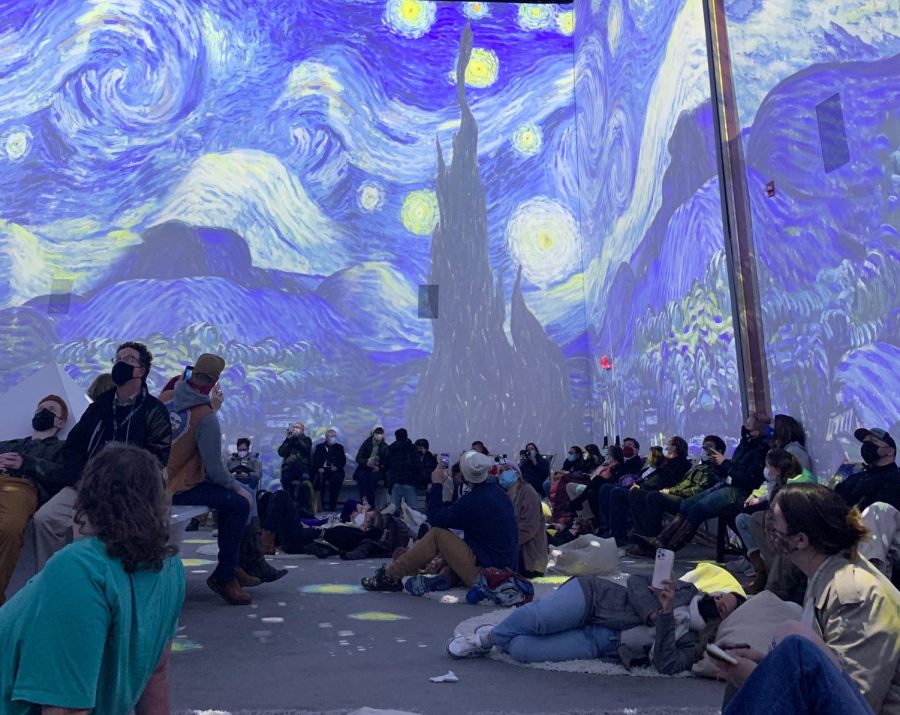The Show Must Gogh On
Van Gogh: The Immersive Experience is a digital art exhibit on display in the Strand Theatre from October 6, 2021 through February 20, 2022. This exhibition was made possible through the partnership of Fever, a global entertainment platform, and Exhibition Hub.
Upon entering, you are greeted with a projected face of the famous Vincent van Gogh on a statue of a head, creating a 3-D effect. While a good thought in theory, the reality of this is a little terrifying, and the rather horrifying expression on van Gogh’s digitized face foreshadows the theme of the rest of the exhibit.
The exhibit begins with reproductions of van Gogh’s most famous works grouped together and displayed under harsh spotlights. With the use of reproductions, one is able to inspect more pieces at a time, while in a museum, it would be unheard of for so many paintings to be displayed together. Upon examination of these prints, however, it is clear what is lost from them: the life. When looking at a real painting, and especially one of van Gogh’s oil paintings, the impasto and the texture of the paint make the viewer all the more aware of the brush strokes that created it. Ms. Judi Freeman, a Boston Latin School history teacher and former art curator, emphasizes, “It is critical […] to see van Gogh in the flesh [because] his works of art consistently look as if they’ve come right off the easel.” A cheaply-made print on canvas does it no justice.
As you move from room to room, you’ll discover a different period of van Gogh’s life and artwork. There is his sunflower series — his work with Japanese style, landscape and rooms — all accompanied by descriptions of the paintings and the state of his life during their creation.
Parker Hastings (III), however, feels that the descriptions “gave the average person a lot more knowledge […] and much-needed insight.” Prior to the exhibit, Hastings only knew van Gogh as “that painter who cut his ear off,” so he enjoyed getting “insight into the history of the paintings.” The descriptions were Hastings’ favorite part of the experience, but that can also be attributed to the allure of the artist’s life.
Following the reproductions of van Gogh’s paintings and some photo-ops comes the truly immersive part of this experience: the 35-minute, 360-degree digital show. When I first entered the room, I was mesmerized. Boats moved, clouds drifted across the sky, lights shimmered on water and raindrops fell onto the floor. Images of different perspectives of the same subject morphed into each other, and an entire section was dedicated to watching van Gogh’s self-portrait drift farther and farther from reality.
It was beautiful seeing people around you immersed in the same experience. There was a silent appreciation of what was happening around us, but that silence was soon broken, both literally and figuratively. The show was over; children ran around the room, and reality dawned on me. I paid 50 dollars, including fees and services, to sit on IKEA furniture printed with Starry Night and see images projected onto walls. Moreover, all the money from the nearly sold-out exhibition went to the companies, and not a penny went to the late Vincent van Gogh.
These kinds of exhibitions succeed in making a profit because of people’s hunger for entertainment. There are many other “immersive” van Gogh experiences in the country, and people attend them. While the shows excel in giving the average person insight into an artist’s life, they are gimmicks. Ms. Freeman puts it best: “Money cannot replace the uniqueness of a work of art, but we’re living in a world where it’s all been monetized.”








